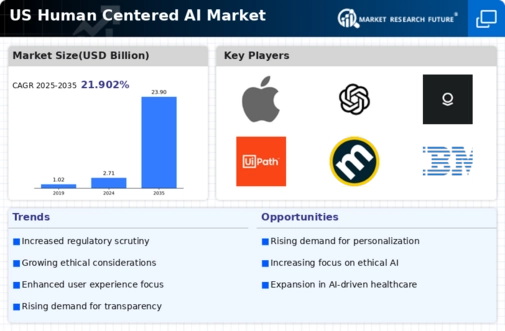The human centered-ai market is currently characterized by intense competition and rapid innovation, driven by advancements in artificial intelligence and increasing demand for user-centric solutions. Major players such as OpenAI (US), Google (US), and Microsoft (US) are at the forefront, each adopting distinct strategies to enhance their market positioning. OpenAI (US) focuses on developing advanced AI models that prioritize ethical considerations and user engagement, while Google (US) leverages its vast data resources to refine its AI capabilities, emphasizing integration across its product ecosystem. Microsoft (US), on the other hand, is heavily investing in partnerships and cloud-based solutions, aiming to embed AI functionalities into its software offerings, thereby enhancing user experience and operational efficiency.
The business tactics employed by these companies reflect a concerted effort to optimize their operations and adapt to market demands. The competitive structure of the human centered-ai market appears moderately fragmented, with a mix of established giants and emerging startups. This fragmentation allows for diverse innovation pathways, although the influence of key players remains substantial, as they set industry standards and drive technological advancements.
In October 2025, OpenAI (US) announced a strategic partnership with several educational institutions to develop AI-driven learning tools aimed at enhancing personalized education. This initiative not only underscores OpenAI's commitment to ethical AI but also positions it as a leader in the educational technology sector, potentially reshaping how learning is approached in the digital age. The collaboration is likely to expand OpenAI's reach and influence in the market, fostering a new generation of AI applications tailored for educational purposes.
In September 2025, Google (US) unveiled its latest AI model, designed to improve natural language processing capabilities across its platforms. This launch is significant as it enhances Google's competitive edge in the AI landscape, allowing for more intuitive user interactions and better integration of AI into everyday applications. The model's capabilities may lead to increased user engagement and satisfaction, reinforcing Google's position as a leader in AI technology.
In August 2025, Microsoft (US) expanded its Azure AI services by introducing new tools aimed at small and medium-sized enterprises (SMEs). This move is strategically important as it democratizes access to advanced AI technologies, enabling SMEs to leverage AI for operational improvements. By focusing on this segment, Microsoft not only broadens its customer base but also fosters innovation among smaller businesses, which could lead to a more vibrant ecosystem of AI applications.
As of November 2025, the competitive trends in the human centered-ai market are increasingly defined by digitalization, sustainability, and the integration of AI into various sectors. Strategic alliances are becoming more prevalent, as companies recognize the value of collaboration in driving innovation and enhancing market presence. Looking ahead, competitive differentiation is likely to evolve, shifting from traditional price-based competition to a focus on innovation, technological advancement, and supply chain reliability. This transition may redefine how companies approach market challenges, emphasizing the importance of agility and responsiveness in a rapidly changing landscape.

























Leave a Comment